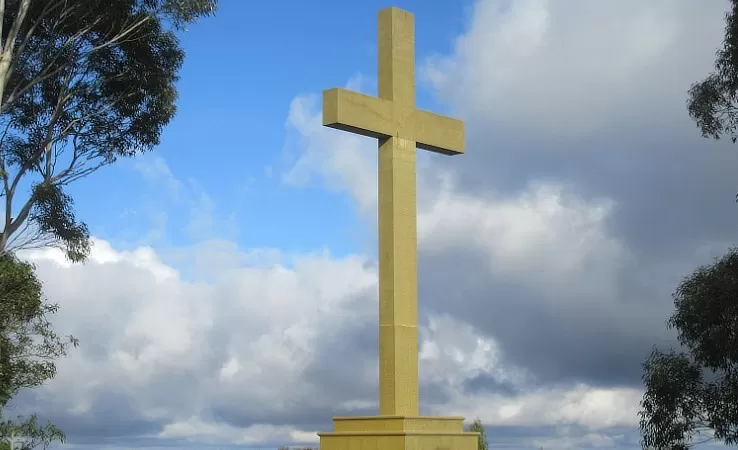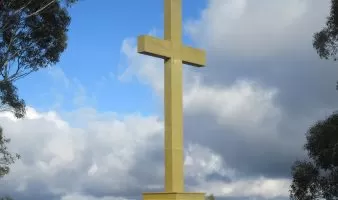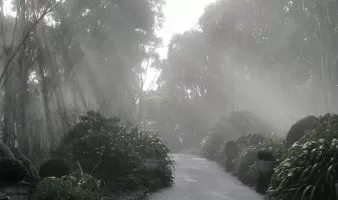Contrasted against the dry Western plains, Mount Macedon is wonderfully damp, all misty forests, moss covered trees and panoramic views. The panorama from Major Mitchell’s lookout (after surveyor general Major Thomas Mitchell) is spectacular, a glorious sweep of the plains below, the remains of volcanic caldera dotting the horizon and yes, in the distance Port Phillip Bay. Mitchell must have been reading the classics at the time of his expedition into “Australia Felix”, for it appears he named Mount Macedon in honour of Phillip of Macedonia, progenitor of Alexander the Great.
The memorial cross that now stands on the summit is twenty one metres high, clad in warm wattle yellow tiles that were designed to stand out against the “sombre colour of the … bush”. The dull gum-tree green of that bush now partially conceals its presence but originally, the cross was ““conspicuous for miles across the plains 2,000 feet below”, glowing in the sunlight and adorned with the bronze sword of the crusaders. The visitor approaches along Cameron Road, lined with meticulous and beautifully maintained Italianate landscaping, reminiscent of so many Roman villas. As we are drawn toward it, the cross is silhouetted against the sky and we are obliged to look up in awe and then, like Mitchell, out over “our” dominion, stepping up onto the huge elevated concrete base, all things mundane beneath us. The view is glorious. The bronze inscription on the front shouts “TO THE GLORY OF GOD AND IN MEMORY OF AUSTRALIA`S SONS 1914-1918.” The “…AND IN…” is so much like an after thought and indeed, Cameron’s cross was built seventeen years after the event, primarily to provide ‘susso’ relief for depression wracked labour. An act of generosity he could afford.
This cross, however, is a duplicate of one destroyed by fire in 1987, reconstructed by the Grollo brothers, those conspicuous constructors of modern Melbourne. Perhaps this Latin association explains the curious mix of Mediterranean cultures that signify the architecture of this monument. This cross and surrounds now have heritage listing and attract hoards of tourists, including myself, to the view.
Despite the complexity of its history, the social narrative of the cross as a memorial is unmistakable. This is muscular Christianity writ large, triumphalism at its zenith. As a memorial to World War One, it is deeply ironic. This was a war in which both sides spoke in the language of Christian crusaders, swords and Maltese crosses. God was with all of us apparently. But the signification here is actually a line of European conquerors stretching back past Christianity to .. Phillip of Macedon? The cult of the warrior is eerily present. “Death Cannot Rob Them Of – Their Glory,” proclaims the inscription, “Nor Time Efface – The Memory Of Their Gallant Deeds” suggesting an Alexander buried somewhere nearby. But in fact the dead are invisible here. There are no graves. There are no walls listing the names of the fallen. Indeed, there is no statuary to evoke the human form at all. The ‘conquest’ here denotes the imposition of a culture on an ancient land as much as a crushing of any actual foe.
Elsewhere, scattered on the lower slopes are an odd assortment of markers to various conflicts and calamities: an air-crash on the mountain, Korea… Vietnam again. There are also markers to those who wish to be associated with power. (I note that Jeff Kennet has managed to have himself named as part of the restoration of the cross.) Although spectacular, the cross does not in any way invite reflection on the “horror and tragedy and … inexcusable folly” of the ‘Great War’.
A better symbol of that loss beyond comprehension is told in the myriad of tiny hamlets, many now no more than names, spread across the Western district. On small unassuming obelisk, the names of fathers and sons and brothers and cousins list the repetitive refrain of family names. This country-side was once depopulated by the effectiveness of the King’s recruiters persuading young and not so young alike that this “would be an adventure too grand to miss..”.
Unfortunately, the harvest of death did not produce our answer to Wilfred Owen, or that generation of poets who saw the truth of those “who die as cattle”. For us it produced Charles Bean and the foundation myth of a blood sacrifice among sun-kissed warriors, noble, “resilient, .. laconic and duty bound”. Each Anzac day I am struck by the bizarreness of “celebrating” being on the wrong side of history. We invaded a country on the other side of the world, slaughtered its citizens and were beaten back, and this was our country’s finest moment: the moment when a federated nation was really born? It was not Parkes’ long, peaceful act of persuasion but a pointless, impulsive act of idiocy. Still, we were not alone. Crowds in Berlin cheered the declaration of war in 1914 before more than two million of Germany’s young men are turned into fertiliser and ploughed into the earth.
Every year with increasing intensity, sentimentality and absurdly grandiose pretension, hoards of young people wearing their grandfather’s medals re-invade another land to wrap themselves in the flag, a morbidly absurd version of holidays in Bali. I can’t imagine what the Turks think of this annual invasion. They are more generous than we have ever been. There are no monuments here to the sons of Ataturk. No leader here proclaimed to the mothers of Turkey’s dead, your sons “have become our sons as well.” Every year this immersion into the swamps of jingoism becomes more and more ludicrous. Grown men haunt old battlefields dressed in century old military regalia, pretending…. what exactly? Not actual war that is certain. Young women “re-enact” the frantic charge of Beersheba, …slowly, … trotting to maintain their insurance coverage. Thousands attend dawn services, with mawkish emotion, responding to the bugle call and tucking into sausages and bacon, orange juice and coffee. “Lest we forget” has acquired magical powers designed precisely to stop up memory.
The narrative of sacrifice suggests death chosen for a noble cause but this was not the universal experience. Australians with Irish ancestry did not buy into the concept of nobility (that was constructed decades later). Rather they saw the bastardy of the Black and Tan, that murderous lumpen proletariat that worked their way through Ireland, courtesy of the “Mother Country”. Those abusers of human rights were too criminally base to be “sacrificed” on the field of battle but not too base to keep the Irish in their place. The furious resistance to conscription is also absent from the national narrative, the pacifists, like the sectarian Irish Catholics have been erased. We speak coyly, but are not entirely ashamed of the white feather brigade who, in the form of a middle-aged woman, pressed one such feather into the hand of my seventeen year old grandfather dressed in his railway porter’s uniform. This was a man who hated all violence but who loved poetry.
There was no glory for those who drowned in bomb craters, were crucified on barb-wire, cut in half by machine guns, suffocated in the mustard gas, starved to death, the wounded left “to die … in the half frozen mud”. There was no glory for those who died, barely more than children, driven mad by the obscenity, executed by their own armies for cowardice and desertion. No memorials to those poor creatures. Our obsession with the cult of the warrior, the hero, has no room for realities. Between nine and 11 million men were ground into blood and bone. Another six million civilians died from starvation and deprivation caused by the war, a war entirely without purpose or point, a war without morality. But I digress…
For those interested in the causes of World War One:
http://www.historyhome.co.uk/europe/causeww1.htm



